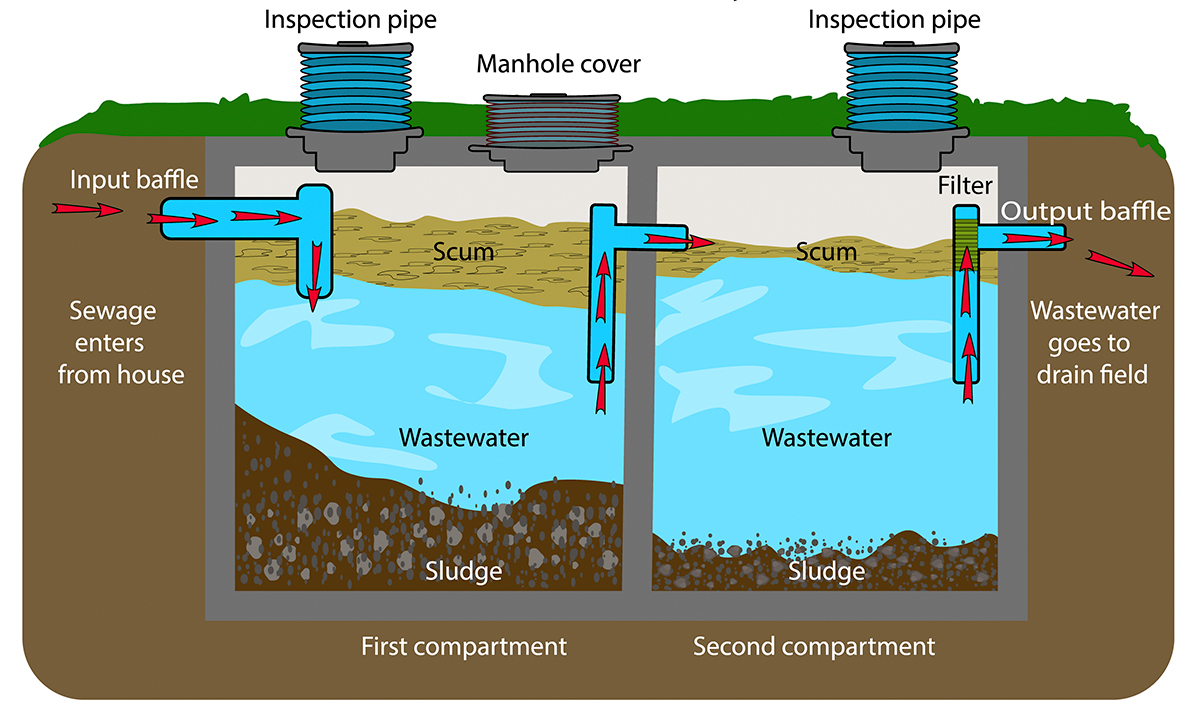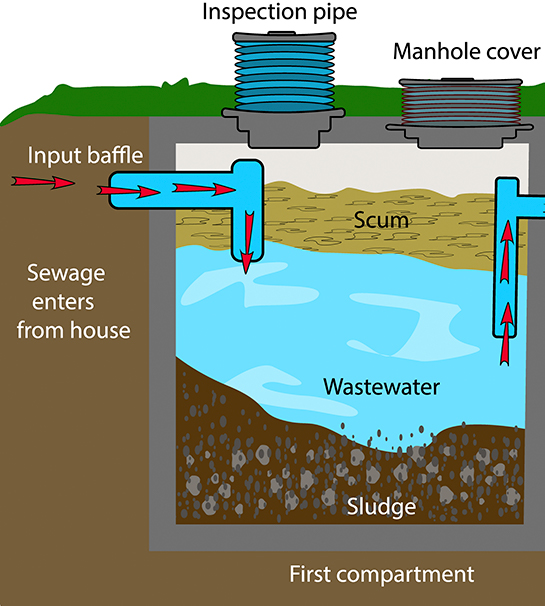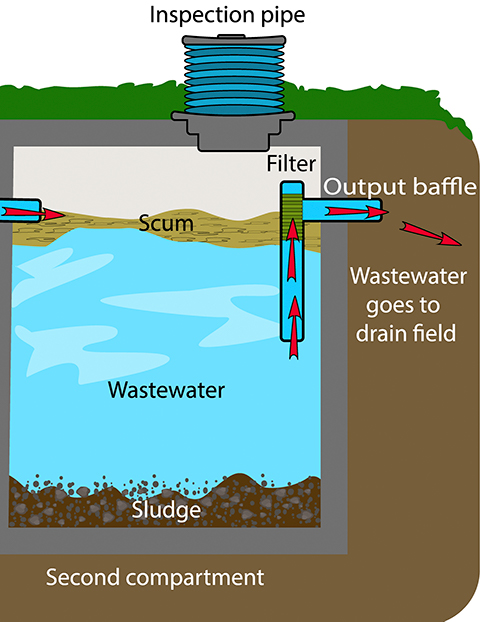Consumer Information
What is a Septic System?

A septic system is an on-site recycling system which treats wastewater and returns it to the groundwater. If properly designed, installed, used and maintained, a septic system can do its work safely and efficiently for many years. Improper design, installation, use and/or maintenance can lead to premature and costly failure. We encourage you to understand how your system operates, to use and maintain it properly to protect your investment and the environment.
A septic system typically consists of two components: the septic tank and the Effluent Disposal Area (EDA), sometimes referred to as the leachfield. These components treat and renovate the wastewater. A septic system has primarily two jobs to do:
- It must dispose of the wastewater
- It must treat wastewater so it is suitable for return to the groundwater and soil
Once a system is in place, it’s now up to you, the system owner, to perform critical steps in proper use and maintenance.

The Septic Tank
The septic tank provides the first step in treatment. Its primary purpose is to protect the drainfield or other system components from becoming clogged by solids suspended in the wastewater. The wastewater is discharged from the home directly into the tank where it is retained for a day or more. During this time in the tank, the heavier solids settle to the bottom to form a sludge layer and lighter solids, greases, and oils float to the top to form a scum layer.
In addition to acting as a sedimentation chamber and providing storage for the sludge and scum, the septic tank also digests or breaks down the waste solids. Anaerobic and facultative micro-organisms that thrive without oxygen feed on the solids to reduce the volume of sludge and scum. In the process, carbon dioxide, hydrogen sulfide, and other gases are produced, which must be vented from the tank through the plumbing vent on your property’s roof. Only about 40 percent of the sludge and scum volume can be reduced in this manner, however, so the tank must be pumped regularly to remove the accumulated solids. If you don’t pump the tank regularly, it will fill with sludge and the solids will be washed out into the drainfield where they will quickly clog the soil.

The Effluent Disposal Area
The effluent disposal area (EDA) is the place where the effluent (liquid) flowing from the septic tank is treated and returned to the groundwater. The purpose of proper design—and of specification codes—is to provide and assure an appropriate site for this to take place.
In general, the EDA must be placed on permeable, dry soils. Codes generally specify a vertical separation space between the bottom of the leaching area and water table, ledge or bedrock, or other limiting factors. As well, horizontal separation distances to wells, streams, and other features are prescribed in state rules governing system design and construction. When these are maintained, the soil will act as a biological filter and treatment unit, removing harmful bacteria and viruses from the effluent stream, returning the wastewater safely to the water table.
A number of different types of EDAs may be used, including stone and pipe, mounds, chambers, “proprietary devices”, pressure-dosed systems, contour systems, and others.
Taking Care of Your System
Your on-site wastewater treatment system represents a significant investment that you will want to protect. With proper operation and regular maintenance, your system will function better and last longer.
Do not wait until your system shows signs of failure to have your septic tank pumped out. Waiting can mean complete clogging and an expensive repair bill. Call a septic system pumper to inspect your system AT LEAST ONCE EVERY THREE YEARS and pump as needed. Periodic pumping of the septic tank is far less costly than repair or replacement of the entire system.
While your tank is being pumped, ask the operator to examine the inlet and outlet baffles or tees in the septic tank. If either is broken, have repairs done immediately. The inlet should also be checked to see if wastewater is continuously flowing into the tank from previously undetected plumbing leaks. The outlet baffle is more important than the inlet baffle. Its loss will allow untreated material to go directly to the absorption area; failure of the system is the common result.
Septic systems generally give little warning that they are about to fail. However, the following symptoms often indicate the leaching system is becoming clogged:
a) Sewage odor near the septic tank or leaching area
b) Slowly running drains and toilets
c) Sewage on the ground over the leaching area
Protect the system by keeping soil over the drainfield covered with vegetation to prevent erosion. Don’t drive heavy vehicles over the system; and avoid construction over the system. Maintain natural shape of the land immediately down slope of the system and protect this area from cutting and filling. Landscape the yard to divert surface waters away from the tank and drainfield. Be sure that water from the roof, gutters, and foundations drains do not flow over or into the system.
System  Dos and
Dos and  Don’ts:
Don’ts:
 Some DOs:
Some DOs:
Do conserve water to reduce the amount of wastewater that must be treated and disposed.
Do only discharge biodegradable wastes into system.
Do keep your septic tank cover accessible for tank inspections and pumping. Many persons install a concrete riser (or manhole) over the tank, if it is buried six inches or deeper, to provide easy access for inspection and pumping. Don’t cover the septic tank or drainfield with asphalt or concrete.
Do have your septic tank pumped regularly and checked for leaks and cracks. Tanks should be pumped at least once every three years. Keep a schedule and record of past and future inspections and pumping. (Use the chart on the back cover.)
Do be sure that water from the roof, gutters, and foundation drains do not flow over, or into, the system.
Do call a septic professional when you have problems.
Do compost your garbage or put it in the trash, rather than into the septic system.
Do keep deep rooted trees and bushes away from the leaching system.
Do restrict use of a garbage grinder/disposal. Waste from garbage grinders will fill your septic tank more rapidly, requiring more frequent pumping, but will also float and increase the scum blanket thickness.
 Some DON’Ts:
Some DON’Ts:
Don’t flush cigarette butts, cotton swabs, cat box litter, sanitary napkins, tampons, disposable diapers, condoms and other non-biodegradable products into your system.
Don’t poison your system by dumping solvents, oils, paints, thinners, disinfectants, pesticides or poisons down the drain which can kill bacteria that help purify sewage and can contaminate groundwater.
Don’t dig into your drainfield or build anything over it.
Don’t plant anything over your drainfield except grass.
Don’t drive over your drainfield or compact the soil in any way.
Don’t empty large quantities of water from items such as hot tubs, or whirlpools, particularly if they are chlorinated.
Don’t put in a separate pipe to carry wash waters to a side ditch or the woods. The graywater contains germs that can spread disease.
Don’t wait for signs of failure.
Don’t attempt to repair a failing system yourself. Hire an experienced septic system contractor. A repair permit may be needed from your local health department.
Other System Management and Maintenance Tips:
Water conservation will extend the life of your system.
Drainfields do not have unlimited capacity. Drainfields are usually designed for a limited gallonage capacity per bedroom per day. Overloads can occur seasonally or daily.
Save money. Commercial septic tank additives are not necessary. The bacteria needed for partially decomposing the tank solids are naturally present in sewage. Even if you use additives, you will still need to pump the solids out of your tank.
When working with septic systems, do so carefully and safely. Sewage contains germs that can cause diseases. Never enter a septic tank. Toxic and explosive gases in the tank present a hazard. Old tanks can collapse. Electric controls present a shock and spark hazard. Secure the septic tank lid so children cannot open it.
State laws require you get a permit before repairing a failing system. It is important the system is repaired as soon as possible to minimize the health risk to your family and community.
Some Signs of Possible Septic System Problems:
- Sewage backing up into toilets, tubs or sinks.
- Slowly draining fixtures; particularly after it has rained.
- The smell of raw sewage accompanied by extremely soggy soil over the drainfield.
- Sewage discharged over the ground or in nearby ditches or woods. This is defined as failure in most codes.
- Water test results indicating the presence of biological contamination or organic chemical contamination in the groundwater under the system.

